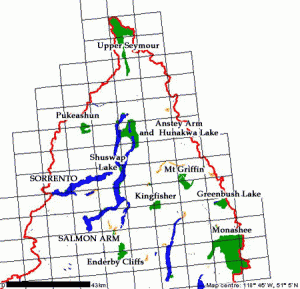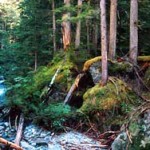Anstey Arm/Hunakwa Lake Park
Upper Seymour River Park
Pukeashun
Enderby Cliffs
Mount Griffin Ecological Reserve Addition
Kingfisher Creek Ecological Reserve Addition
Eagle River
English Lake
Mara Meadows Ecological Reserve Addition
Pillar
Shuswap River Islands
Shuswap Lake Marine Park Additions, including Bughouse Bay Site
Upper Perry River
Upper Violet Creek
White Lake Park Additions
Yard Creek Provincial Park Additions
Other New Parks
Momich Lake Park
Upper Adams River
Adams Lake Provincial Park
Spillman Beach
Popular Point
Oregano Creek
In 1991, Shuswap Environmental Action Society published edition two of the Shuswap Eco-Watch that featured a satellite image of the Shuswap in full colour. Inside, was a proposed “Sustainable Stewardship Plan” that called for the creation of 14 new parks. Over the next ten years, SEAS members campaigned for the creation of new parks in the 708,500-hectare Salmon Arm forest district where only .4 percent was in parkland and ecological reserves. The SEAS campaign included five years of letter writing; the production of educational newspapers, columns, and a video; tours, field trips and airplane flights; slide shows, and numerous studies. SEAS appreciates the financial support it received from the World Wildlife Fund and the contributions of local artists and supporters that made many of these campaign projects possible.
This campaign work was followed by five years of participation in the Shuswap/Okanagan LRMP process (see Land Use Planning). Finally, in January 2001, the B.C. Government announced approval of the Okanagan Shuswap Land-Use Plan that created 49 new parks in the region, including 11 new parks and 6 park additions totalling 26,293 hectares in the Salmon Arm forest district. Although the parks have been created, much work remains and SEAS will continue to remain involved in upcoming development of the park management plans.
SEAS also participated in the Kamloops LRMP that was completed in 1995. It was the first LRMP in the province. Two Goal ! provincial parks were created in the Adams Lake watershed, a sub-drainage of the Shuswap watershed, totaling 6,810 hectares (see below).
True wilderness is free both from human management and damaging human activities, a place where nature rules. But due to over a century of logging, mining, settlement and agriculture, such places were difficult to find in the Shuswap in low or mid-elevation areas. The 17 new protected areas include seven of the larger Goal I areas and ten of the smaller Goal II areas. Note that some of the Goal II areas have not yet been legislated as Class A Parks to to issues such as maintaining access. To learn more about BC Parks, go to their webpage: www.env.gov.bc.ca/bcparks
Because of the Liberal government’s cost cutting measures, funding for BC Parks was cut and some parks were closed. All park interpretation programs were closed, however in some parks, interpretation is provided by non-profit groups. There is now concern that new regulations will cause increased commercialization in parks. While Shuswap’s new parks are so far protected from development, there is little likelihood that the current government will ever fund any infrastructure improvements such as trails or campgrounds. Park planning has been completed for Upper Seymour, Enderby Cliffs and Greenbush Lake, Anstey-Hunakwa and Pukeashun. Planning documents are available on the BC Parks website.
[This report was written in approximately 2006 and updated February, 2019.]
NEW GOAL I PARKS
Anstey Arm/Hunakwa Lake Park – 7,492 hectares
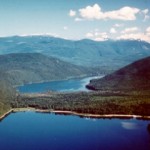 A landsat satellite photo helped SEAS identify the Hunakwa Lake area, which had remained relatively free from logging. On the satellite photo, a patchwork of clearcuts surrounds the unbroken band of green forest above Hunakwa Lake and the Anstey Arm of Shuswap Lake. The Anstey Arm/Hunakwa Lake Park includes old growth forests, natural Shuswap Lake foreshore, wetlands and key wildlife habitat. A nature lover’s paradise, Hunakwa Lake is the only remaining low elevation, unroaded, mid-sized lake in the province’s southern interior (and quite likely in this part of North America). This new park connects the Anstey Arm with the Seymour Arm of the Shuswap Lake and includes Wright Lake, where naturalists identified a great diversity of ferns, flowers, shrubs and trees. Hikers can reach the trails to Wright Lake and Hunakwa Lake via the Beach Bay Access Road. Boaters can gain access to trails into the area from Wright Creek on Seymour Arm or from the north end of Anstey Arm.
A landsat satellite photo helped SEAS identify the Hunakwa Lake area, which had remained relatively free from logging. On the satellite photo, a patchwork of clearcuts surrounds the unbroken band of green forest above Hunakwa Lake and the Anstey Arm of Shuswap Lake. The Anstey Arm/Hunakwa Lake Park includes old growth forests, natural Shuswap Lake foreshore, wetlands and key wildlife habitat. A nature lover’s paradise, Hunakwa Lake is the only remaining low elevation, unroaded, mid-sized lake in the province’s southern interior (and quite likely in this part of North America). This new park connects the Anstey Arm with the Seymour Arm of the Shuswap Lake and includes Wright Lake, where naturalists identified a great diversity of ferns, flowers, shrubs and trees. Hikers can reach the trails to Wright Lake and Hunakwa Lake via the Beach Bay Access Road. Boaters can gain access to trails into the area from Wright Creek on Seymour Arm or from the north end of Anstey Arm.
See: Anstey/Hunakwa Map
Experience Anstey Arm/Hunakwa Lake Park
July 2000 Kamloops Daily News Feature article on Hunakwa Lake
Upper Seymour River Park – 10,580 hectares
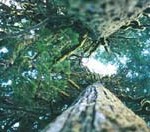 A tip from a bulldozer operator about building a road through a stand of giant trees alerted SEAS to the conservation values of the Upper Seymour River Valley. SEAS then persuaded government staff to visit the area, which helped result in interim protection. Subsequently, SEAS field trips to the Seymour River headwaters found exceptionally large cedar trees up to 12 feet in diameter. Forest ecologists have since estimated this undisturbed “antique” rainforest to be thousands of years old as evidenced by the many layers of distinct lichen species and the very wet climate (see Antique Oroboreal Rainforest). As well, this forest provides rare early winter habitat for the endangered Mountain Caribou. When the area was threatened by logging, SEAS garnered public support and then met with the Ministry of Forests Regional Manager who later made a compromise decision that allowed only the first of three cutblocks to be logged. Finally, after years of land use planning deliberations, the headwaters of the Seymour River was made a park, protecting one of B.C.’s few remaining, globally unique, interior rainforests.
A tip from a bulldozer operator about building a road through a stand of giant trees alerted SEAS to the conservation values of the Upper Seymour River Valley. SEAS then persuaded government staff to visit the area, which helped result in interim protection. Subsequently, SEAS field trips to the Seymour River headwaters found exceptionally large cedar trees up to 12 feet in diameter. Forest ecologists have since estimated this undisturbed “antique” rainforest to be thousands of years old as evidenced by the many layers of distinct lichen species and the very wet climate (see Antique Oroboreal Rainforest). As well, this forest provides rare early winter habitat for the endangered Mountain Caribou. When the area was threatened by logging, SEAS garnered public support and then met with the Ministry of Forests Regional Manager who later made a compromise decision that allowed only the first of three cutblocks to be logged. Finally, after years of land use planning deliberations, the headwaters of the Seymour River was made a park, protecting one of B.C.’s few remaining, globally unique, interior rainforests.
Upper Seymour River Park photo gallery
Journey into the Upper Seymour video
Journey into the Upper Seymour – article and photos
Pukeashun – 1,571 hectares
The Pukeashun Mountain area was first identified on a satellite photo and then its pristine nature was confirmed by airplane surveillance. The area is approximately 15 kilometres east of Albas on Shuswap Lake. This new park includes Grizzly Lake and thus protects a small part of the headwaters of Scotch Creek. Although this park is small, it protects a biologically significant linkage between wetlands, an old growth spruce forest and undisturbed alpine flower meadows. This area is key habitat for bull trout, Grizzly bear, and Mountain caribou.
See Pukeashun Map
Enderby Cliffs – 2,364 hectares
This popular hiking area and lookout point above the community of Enderby is also the major scenic viewshed for travellers entering the Shuswap area from the Okanagan valley. This new park protects some rare forest types, a small lake and a linkage between dry and moist forest zones.
Mount Griffin Ecological Reserve Addition–1,566 hectares
Located about 25 kilometres south of Three-Valley Gap, the original 1,376 hectare Ecological Reserve was an odd shape, narrow in the middle and pointed at the top (see Ecological Reserves below). It was established in 1972 to protect an elevational sequence of habitats from valley bottom wetlands to alpine meadows in an area with a wet interior climate. The addition adds significant wetlands, two lakes and old growth forested areas to the centre and top, thus increasing its value to conservation.
See Mt. Griffin Ecological Reserve Addition Map
Kingfisher Creek Ecological Reserve Addition–414 hectares
The 1,441-hectare Kingfisher Creek Ecological Reserve was established in 1972 to protect representative subalpine parkland in an area transitional between dry and wet interior climates. Located in the headwaters of Kingfisher Creek that drains into Shuswap River near Mable Lake, this reserve is adjacent to the Hunter Range alpine and thus receives some summer grazing by cattle. The addition improves the ecological viability of the reserve by adding more stands of old growth forest.
See Kingfisher Creek Ecological Reserve Addition Map
NEW GOAL II PARKS
Eagle River–508 hectares
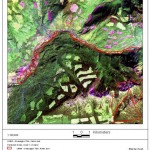 This park protects a portion of the riparian zone along the Eagle River east of Malakwa.
This park protects a portion of the riparian zone along the Eagle River east of Malakwa.
English Lake–446 hectares
Click on a photo to view in a larger format
This park protects the headwaters of a very small river that flows into the Eagle River just east of Three-Valley Gap near Victor Lake. Included in the park are stands of ancient cedar-hemlock forests; an unusual riparian area with very thick layers of moss atop boulders; critical grizzly bear habitat; and English Lake nestled in a subalpine valley below Mount MacPherson.
Mara Meadows Ecological Reserve Addition–207 hectares
The Mara Meadows Ecological Reserve was established in 1972 to protect unique calcareous fens (a type of wetland) that contain rare orchids, a high diversity of plants, Sandhill Crane nesting habitat, and habitat for at least 50 other bird species. A permit is required to enter this reserve. The addition adds a larger forest buffer to help protect the meadows and bogs..
Pillar – 3 hectares
This park protects a unique conglomerate stone pillar left after many centuries of erosion. It is situated close to Pillar Lake, above the community of Falkland.
Shuswap River Islands–187 hectares
This park protects wetlands, critical wildlife habitat and deciduous forests.
Shuswap Lake Marine Park Additions, including Bughouse Bay Site – 43 hectares
A few more sites have been added to this popular marine park system that provides many camping opportunities for tourists and locals in houseboats and other watercraft.
Upper Perry River–164 hectares
The park protects the headwaters of the Perry River that flows into the Eagle River east of Malakwa. In addition to the old growth cedar-hemlock forest, the park includes interesting rock formations and a possible trail route to alpine hiking areas.
See: Upper Perry Map
Upper Violet Creek–107 hectares
This park protects the riparian zone of the creek that feeds into the Mara Meadows.
White Lake Park Additions–255 hectares
This park protects much of the eastern shoreline of White Lake and a portion of White Creek that contains critical trout spawning habitat. It also protects habitat for some endangered orchids found on the south-east side of the lake. The new park will add additional camping areas for this popular fishing lake.
Yard Creek Provincial Park Additions–116 hectares
Yard Creek is a popular camping site adjacent to the Trans-Canada highway near Malakwa. The addition adds a small nature reserve to the park. Unfortunately, the B.C. government is now planning to close this park unless another agency such as the community of Sicamous is willing to look after maintenance.
See: Yard Creek Map(100k)
Other New Parks
After four years of workshops, meetings and negotiations, the Kamloops LRMP was concluded in 1995 (see Land Use Planning). The plan created 21 Goal I areas and 40 Goal II areas totalling 107,500 hectares, including the following new parks in the Adams River watershed that flows into the Shuswap watershed.
Goal I Provincial Parks
Momich Lake Park–1650 hectares
Click on a photo to view in a larger format
This park protects a beautiful small valley bottom that contains nearly an entire watershed with three lakes, wetlands and a river that supports salmon and trout. As well, the park protects habitat for moose, deer and goats. There are some remnant stands of old growth interior Cedar-Hemlock forests and there is a beautiful waterfall on Cayenne Creek that flows into the Momich River just below the easternmost lake. Excellent beach campsites are located along Adams Lake just north of where the Momich River enters the lake. Other campsites can be found at both ends of the largest Momich Lake. Canoeing and boating is excellent in the Momich, with opportunities for fishing and wildlife viewing. The many culturally modified trees, evidence of pit houses, and pictographs confirm Shuswap First Nation use of this area. As well, there are the remains of an abandoned logging camp behind the beach on Momich Lake. Momich Lake can be reached by logging roads from either Vavenby, the Adams Lake road or from Seymour Arm on Shuswap Lake via Humamilt Lake.
In the summer and early fall of 2009, a massive fire swept through Momich Lake Park, burning about half of the park’s forests. The park will likely be closed for an indefinite amount of time. Due to instability on the steep hillsides, the logging road that goes through the park from Adams Lake to Humamilt Lake may also be closed. Check with the forest service and BC Parks before visiting this park. To get an idea of the damage, see the fire map.
Sept. 1, 2009 map of Momich Lake fires.
Upper Adams River–5,160 hectares
This park situated at the north end of Adams Lake, contains provincially significant conservation and recreation values. It includes 65 kilometres of undisturbed large river floodplain not found anywhere else in the Interior Cedar Hemlock zone and Tum-Tum Lake. Access is from Highway 5 south of Barriere or from the Trans Canada Highway at Squilax, then 80 kilometres by logging roads along the west side of Adams Lake. There is also access from Highway 5 at Vavenby and 30 kilometres south by good logging roads. The Upper Adams River Provincial Park protects extensive river, riparian and upland forest habitats of the Upper Adams River. This 65-kilometer section of protected river has provincially significant fisheries values for rainbow trout, char and salmon species. The rich variety of habitats provides major contribution to representation of valley bottom ecosystems of the Shuswap Highlands Ecosection. The park offers regionally important recreation opportunities for canoeing, whitewater kayaking, fishing and hunting.
Goal II Provincial Parks
Adams Lake Provincial Park–56 hectares
As a result of the Kamloops LRMP, this park was upgraded from a recreation area to a provincial park in 1996. The park protects beaches and shoreline on Adams Lake as well as mixed forests of aspen, birch, willow, Douglas-fir and cedar. A pleasant beach area with a lightly forested upland, Adams Lake Park is popular for camping, swimming, fishing and boating. The park is located on the southwestern shores of Adams Lake, 15 kilometres of paved and gravel road from Hwy #1 at Squilax, east of Kamloops, 30 kilometres north of Chase. Take the Holding/Adams Lake West Road off the Squilax-Anglemont Road.
Adams Lake Marine Parks, including
Spillman Beach–139 hectares and
Popular Point–32 hectares
These marine parks provide marine access day use and overnight recreation sites, with opportunities for boating, camping, picnicking, swimming and fishing. These sites also have a minor role in representing riparian and associated upland vegetation along Adams Lake.
Oregano Creek–200 hectares
This protected area that has yet to be officially declared a park is located above Tum-Tum Lake and protects a remnant stand of antique cedar-hemlock rainforest including unique lichens.
[Note: the material in this section was prepared by Jim Cooperman and Yuill Herbert. Many thanks to BC Parks, who provided the digital maps. ]
